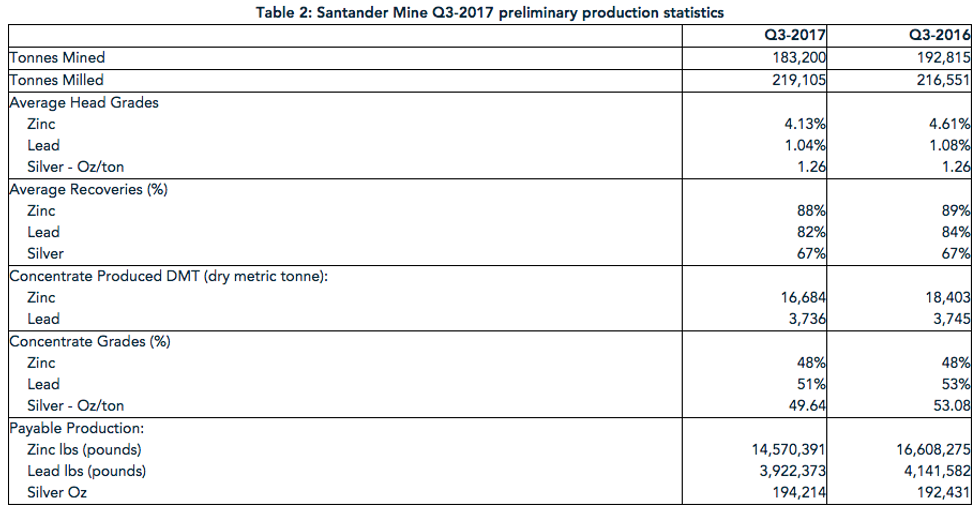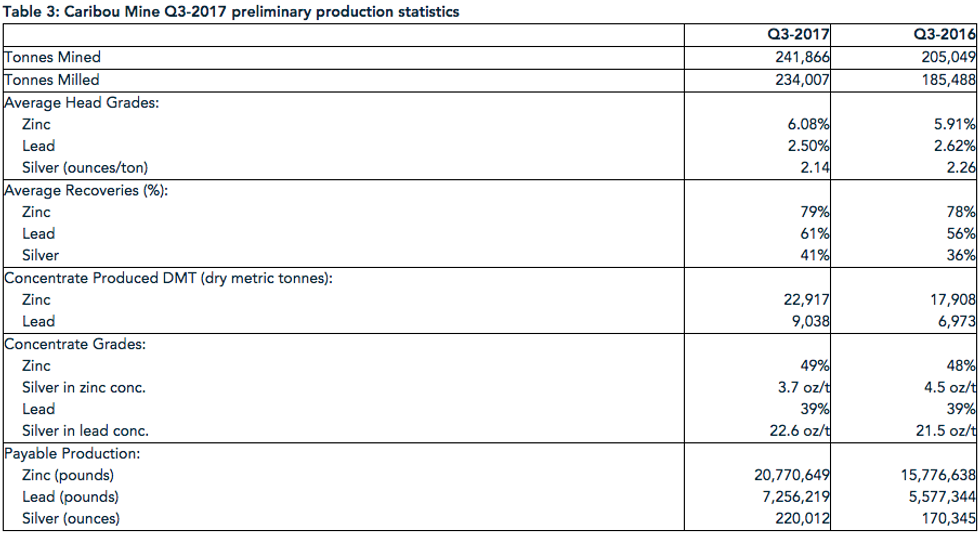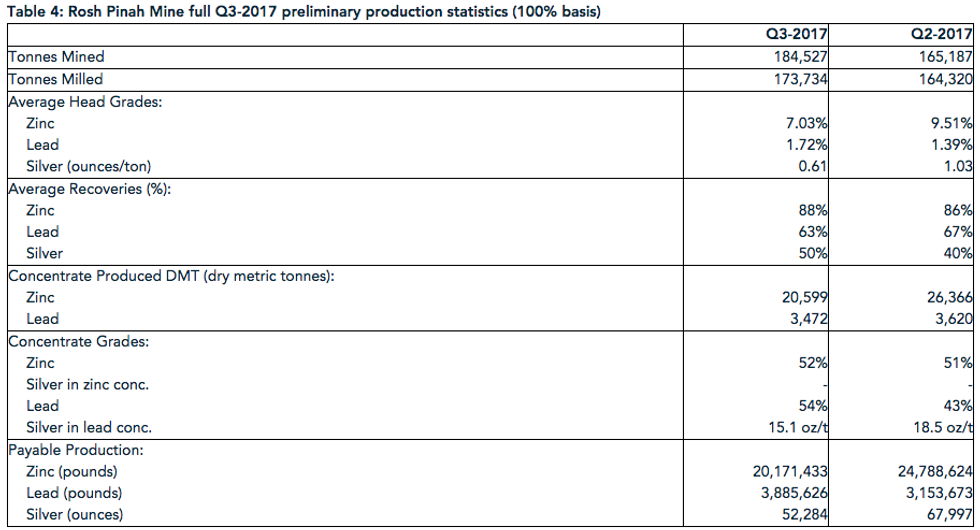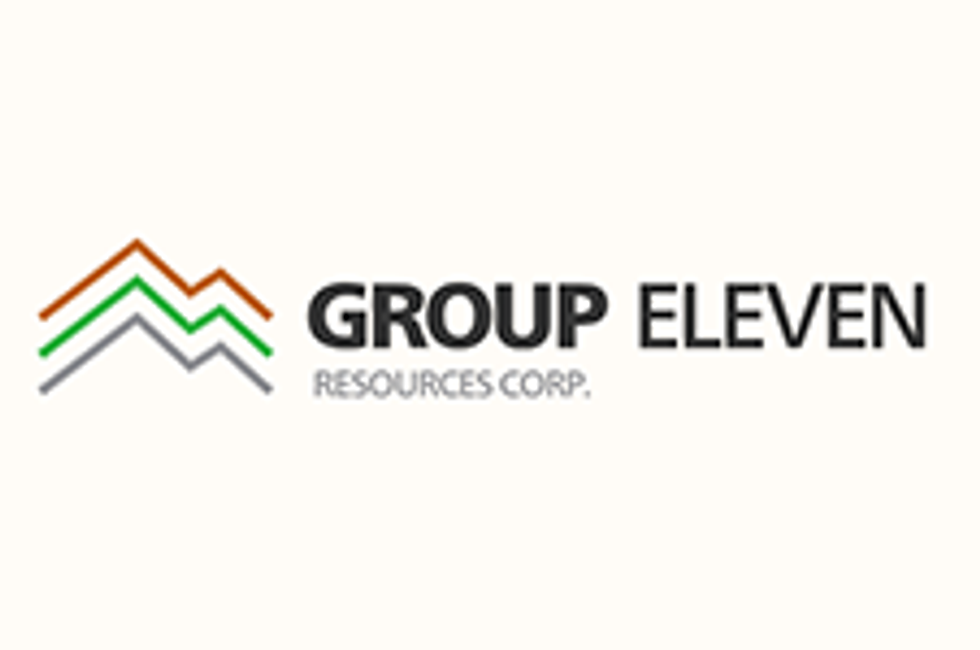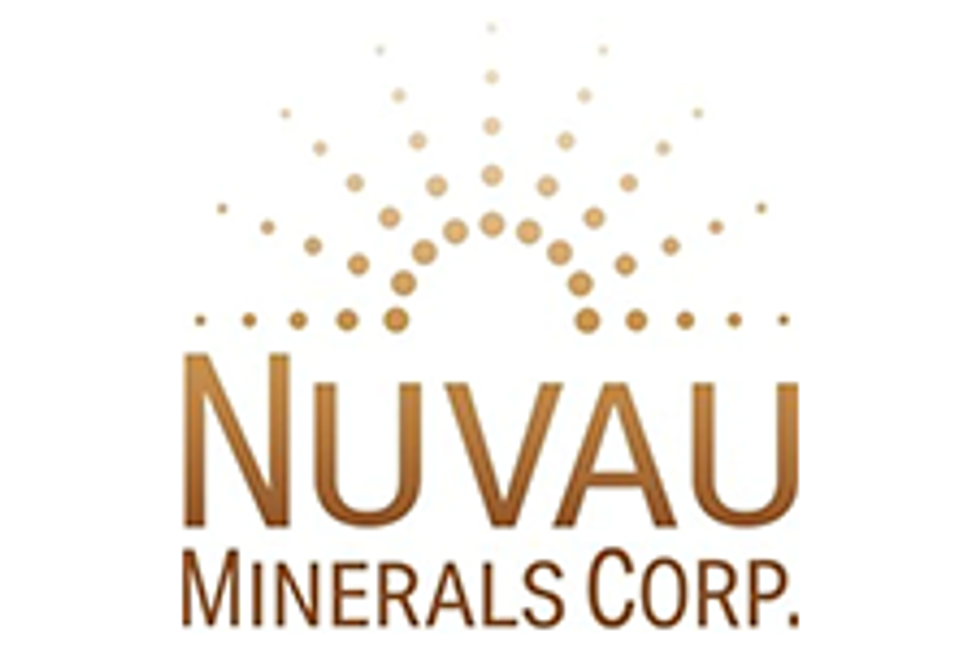
Trevali Mining Corporation (“Trevali” or the “Company”) (TSX:TV)(OTCQX:TREVF)(LMA:TV)(FRANKFURT:4TI) reports record consolidated third quarter (“Q3”) 2017 preliminary production results.
Trevali Mining Corporation (“Trevali” or the “Company”) (TSX:TV)(OTCQX:TREVF)(LMA:TV)(FRANKFURT:4TI) reports record consolidated third quarter (“Q3”) 2017 preliminary production results of 58.4-million payable lbs. of zinc, 12.5-million payable lbs. of lead and 433,442 payable ounces of silver, including September 2017 monthly production from the Rosh Pinah mine in Namibia and Perkoa mine in Burkina Faso that were both acquired from Glencore PLC on August 31, 2017 (Table 1 and see news release TV-NR-17-19).
(1) Q3-2017 and YTD-2017 preliminary production figures include September 2017 production figures from the Perkoa and Rosh Pinah mines following the closure of the African zinc asset acquisition from Glencore PLC on August 31, 2017.
Operational Highlights
- Record overall quarterly zinc, lead and silver production.
- At Santander, mine and mill output increased by 23% and 7% respectively from Q2. Zn head-grades increased 12% and payable metal units have increased 21% for Zn, 29% for Pb and 7% for Ag versus prior quarter.
- Record mill throughput and mine output at Perkoa.
- Material improvements at Caribou – record production during transition period to owner-operated mining activities. September zinc recoveries, metal production and concentrate content set a new monthly record of 81.5% recovery.
- Rosh Pinah mine, mill and zinc recoveries all increased on a quarter-to-quarter basis by 12%, 7% and 2% respectively. The mill re-grind project remains on track and budget for commissioning by year-end.
“Following our August 31st acquisition of the Rosh Pinah and Perkoa zinc mines from strategic partner Glencore, we are excited to report record quarterly metal production for Trevali in Q3,” stated Dr. Mark Cruise, Trevali’s President and CEO. “Integration of the new African mines has progressed well and we are pleased with performance achieved to date. We are also encouraged with the production growth potential identified at these mines and are moving forward on optimization initiatives to further improve metal output.”
Santander Zinc Mine, Peru
Preliminary Q3 Santander production was 14.6 million payable pounds of zinc, 3.9 million payable pounds of lead and 194,214 payable ounces of silver (see Table 2). Recoveries averaged 88% for zinc, 82% for lead and 67% for silver.
Santander mill throughput for Q3-2017 was a new record of 219,105 tonnes, approximately 20% above the nameplate design of 2,000-tonnes-per-day (730,000 tonnes per year). Mine production the quarter was 183,200 tonnes.
Santander metal production, mine output, mill throughput and recoveries all increased significantly in Q3 over the preceding quarter. Tonnes mined over Q3 increased 23% from the preceding quarter, tonnes milled was up 7% over Q2, average zinc head grades increased 12%, and payable Zn, Pb and Ag production were up 21%, 29% and 7% respectively over the prior quarter.
The Company is finalizing the upgrade of its pumping infrastructure to facilitate long-range planning as the mining transitions deeper in the Magistral zones with the system on track for commissioning prior to year-end 2017. It is anticipated to result in reduced power requirements and improve overall mine efficiency upon completion.
2017 Santander Mine Production Guidance (2)
The 2017 production guidance estimate for the Santander mine remains as follows:
- 52-57 million pounds of payable zinc in concentrate;
- 12-14 million pounds of payable lead in concentrate; and
- 700,000-900,000 ounces of payable silver
Total site cash costs for 2017 are estimated to range from approximately US$35-40 per tonne milled.
2 Constitutes forward-looking information. See “Cautionary Note Regarding Forward Looking Statements” at the end of this document.
The Phase I, approximately 13,000-metre, 2017 exploration program commenced during the second quarter utilizing both surface directional and underground drill rigs. The aim of the program is to aggressively probe the depth and lateral extents of the Magistral and Santander polymetallic systems that remain open for expansion in addition to converting additional inferred tonnages into higher confidence categories to support longer-range mine planning.
Caribou Zinc Mine, Canada
Preliminary Q3 Caribou production was 20.8 million pounds of payable zinc, 7.3 million payable pounds of lead and 220,012 payable ounces of silver (see Table 3). Recoveries for the quarter averaged 79% for zinc, a new record. Specifically, September zinc recoveries, metal production and concentrate content set a new monthly record of 81.5% recovery to produce 4,233 tonnes of zinc metal. Mill throughput for the quarter was 234,007 tonnes and mine production was 241,866 tonnes.
With the transition to owner-operated underground mining and the new Sandvik fleet largely in place, mining operations saw improved overall performance including increased tonnes mined (with July averaging a record 3,112 tonnes-per-day), a large decrease in mine dilution to 8.4% (from 18.2% in the first half of 2017) due to the new cable bolter performance and efficiency, and increased operating efficiencies in the new underground haul trucks and scooptrams of 23 and 4.3% respectively.
Caribou metal production, mine output, mill throughput and recoveries all increased notably in Q3 over the preceding quarter. Tonnes mined in Q3 increased 8% from the preceding quarter, tonnes milled was up 4% over Q2, average zinc head grades increased 11%, and payable Zn, Pb and Ag production were up 16%, 6% and 8% respectively over the prior quarter. Unfortunately, despite material production gains made in Q3 and anticipated in Q4, they will be insufficient to enable site to meet 2017 zinc production guidance. Consequently, 2017 guidance has been revised downwards to 81-84 million pounds of payable zinc. Both lead and silver remain unchanged.
2017 Caribou Mine Production Guidance (2)
The 2017 production guidance estimate for the Caribou mine has been revised to:
81-84 million pounds of payable zinc in concentrate;
30-32 million pounds of payable lead in concentrate; and
800,000-900,000 ounces of payable silver
Total site cash costs for 2017 are estimated at approximately US$55-60 per tonne milled.
2 Constitutes forward-looking information. See “Cautionary Note Regarding Forward Looking Statements” at the end of this document.
Rosh Pinah Zinc Mine, Namibia
Preliminary full Q3 Rosh Pinah production was 20.1 million pounds of payable zinc, 3.9 million payable pounds of lead and 52,284 payable ounces of silver (see Table 4). Recoveries averaged 87% for zinc, 63% for lead and 50% for silver. Mill throughput for the quarter was 173,734 tonnes. Only September production is incorporated into the Company’s consolidated preliminary production Table 1.
Rosh Pinah mine output, mill throughput and zinc recoveries all increased in Q3 versus the preceding quarter. Tonnes mined in Q3 increased 12% from the preceding quarter, tonnes milled was up 6% over Q2, Zn recoveries increased 2%, however the average zinc head grade decreased to 7% (from 9.5% in Q2) resulting in lower payable zinc production in Q3. The decrease in the average Q3 zinc head grade was a factor of temporary mine sequencing into a lower-grade portion of the orebody. Mining has now moved back into zones with run-of-mine head grades of approximately 8.5-9% zinc.
2017 Rosh Pinah Mine Production Guidance (2)
The 2017 production guidance estimate (on a full-year basis) for the Rosh Pinah mine is:
- 100-105 million pounds of payable zinc in concentrate;
- 9-11 million pounds of payable lead in concentrate; and
- 200,000 ounces of payable silver
Total site cash costs for 2017 are estimated at approximately US$45-50 per tonne milled.
2 Constitutes forward-looking information. See “Cautionary Note Regarding Forward Looking Statements” at the end of this document.
Perkoa Zinc Mine, Burkina Faso
Preliminary full Q3 Perkoa production was 44.9 million pounds of payable zinc with an average Zn recovery of 91% (Table 5). Mill throughput for the quarter was a record 173,479 tonnes along with record quarterly mine production of 192,392 tonnes. Only September production is incorporated into the Company’s consolidated preliminary production Table 1.
2017 Perkoa Mine Production Guidance (2)
The 2017 production guidance estimate (on a full-year basis) for the Perkoa mine is 165-170 million pounds of payable zinc in concentrate.
Total site cash costs for 2017 are estimated at approximately US$95-100 per tonne milled.
2 Constitutes forward-looking information. See “Cautionary Note Regarding Forward Looking Statements” at the end of this document.
Integration Update
Corporate and Business Unit technical, financial and strategic integration continues to progress well with the team focusing on streamlining system and group synergies and cost savings including supply chain and technical support initiatives.
Qualified Person and Quality Control/Quality Assurance
EurGeol Dr. Mark D. Cruise, Trevali’s President and CEO, Paul Keller, P.Eng, Trevali’s Chief Operating Officer are qualified persons as defined by NI 43-101, have supervised the preparation of and have verified the scientific and technical information that forms the basis for this news release. Dr. Cruise is not independent of the Company as he is an officer, director and shareholder. Mr. Keller is not independent of the Company as he is an officer and shareholder.
ABOUT TREVALI MINING CORPORATION
Trevali is a zinc-focused, base metals mining company with four commercially producing operations.
The Company is actively producing zinc concentrates from its wholly-owned Santander mine in Peru, the wholly-owned Caribou mine in the Bathurst Mining Camp of northern New Brunswick, its 80% owned Rosh Pinah mine in Namibia and its 90% owned Perkoa mine in Burkina Faso. Trevali also owns the Halfmile and Stratmat base metal deposits located in New Brunswick, that are currently undergoing a Preliminary Economic Assessment reviewing their potential development.
The common shares of Trevali are listed on the TSX (symbol TV), the OTCQX (symbol TREVF), the Lima Stock Exchange (symbol TV), and the Frankfurt Exchange (symbol 4TI). For further details on Trevali, readers are referred to the Company’s website (www.trevali.com) and to Canadian regulatory filings on SEDAR at www.sedar.com.
On Behalf of the Board of Directors of TREVALI MINING CORPORATION
Mark D. Cruise, President
Cautionary Note Regarding Forward-Looking Statements
This news release contains “forward-looking statements” within the meaning of the United States Private Securities Litigation Reform Act of 1995 and “forward-looking information” within the meaning of applicable Canadian securities legislation. Statements containing forward-looking information express, as at the date of this news release, the Company’s plans, estimates, forecasts, projections, expectations, or beliefs as to future events or results and the Company does not intend, and does not assume any obligation to, update such statements containing the forward-looking information. Such forward-looking statements and information include, but are not limited to statements as to: The Company’s plan to prepare a new PEA for its Halfmile and Stratmat properties, the accuracy of estimated mineral resources, anticipated results of future exploration, and forecast future metal prices, expectations that environmental, permitting, legal, title, taxation, socio-economic, political, marketing or other issues will not materially affect estimates of mineral resources. These statements reflect the Company’s current views with respect to future events and are necessarily based upon a number of assumptions and estimates that, while considered reasonable by the Company, are inherently subject to significant business, economic, competitive, political and social uncertainties and contingencies.
Many factors, both known and unknown, could cause actual results, performance or achievements to be materially different from the results, performance or achievements that are or may be expressed or implied by such forward-looking statements contained in this news release and the Company has made assumptions and estimates based on or related to many of these factors. Such factors include, without limitation: fluctuations in spot and forward markets for silver, zinc, base metals and certain other commodities (such as natural gas, fuel oil and electricity); fluctuations in currency markets; risks related to the technological and operational nature of the Company’s business; changes in national and local government, legislation, taxation, controls or regulations and political or economic developments in Canada, the United States, Peru, Namibia, Burkina Faso, or other countries where the Company may carry on business in the future; risks and hazards associated with the business of mineral exploration, development and mining (including environmental hazards, industrial accidents, unusual or unexpected geological or structural formations, pressures, cave-ins and flooding); risks relating to the credit worthiness or financial condition of suppliers, refiners and other parties with whom the Company does business; inadequate insurance, or inability to obtain insurance, to cover these risks and hazards; employee relations; relationships with and claims by local communities and indigenous populations; availability and increasing costs associated with mining inputs and labour; the speculative nature of mineral exploration and development, including the risks of obtaining necessary licenses and permits and the presence of laws and regulations that may impose restrictions on mining; diminishing quantities or grades of mineral resources as properties are mined; global financial conditions; business opportunities that may be presented to, or pursued by, the Company; the Company’s ability to complete and successfully integrate acquisitions and to mitigate other business combination risks; challenges to, or difficulty in maintaining, the Company’s title to properties and continued ownership thereof; the actual results of current exploration activities, conclusions of economic evaluations, and changes in project parameters to deal with unanticipated economic or other factors; increased competition in the mining industry for properties, equipment, qualified personnel, and their costs.
Investors are cautioned against attributing undue certainty or reliance on forward-looking statements. Although the Company has attempted to identify important factors that could cause actual results to differ materially, there may be other factors that cause results not to be as anticipated, estimated, described or intended. The Company does not intend, and does not assume any obligation, to update these forward-looking statements or information to reflect changes in assumptions or changes in circumstances or any other events affecting such statements or information, other than as required by applicable law.
Trevali’s production plan at the Caribou Mine is based only on measured, indicated and inferred mineral resources, and not mineral reserves, and does not have demonstrated economic viability. Trevali’s production plans at the Perkoa Mine, Rosh Pinah Mine and Santander Mine are based on both proven and probable reserves and on measured, indicated and inferred mineral resources; mineral resources by definition do not have demonstrated economic viability. Inferred mineral resources are considered too speculative geologically to have the economic considerations applied to them that would enable them to be categorized as mineral reserves, and there is therefore no certainty that the conclusions of the production plans and Preliminary Economic Assessment (PEA) will be realized. Additionally, where Trevali discusses exploration/expansion potential, any potential quantity and grade is conceptual in nature and there has been insufficient exploration to define a mineral resource and it is uncertain if further exploration will result in the target being delineated as a mineral resource.
We advise US investors that while the terms “measured resources”, “indicated resources” and “inferred resources” are recognized and required by Canadian regulations, the US Securities and Exchange Commission does not recognize these terms. US investors are cautioned not to assume that any part or all of the material in these categories will ever be converted into reserves.
Source: www.marketwired.com

